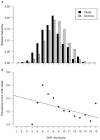A genome-wide association study identifies multiple loci associated with mathematics ability and disability
- PMID: 20039944
- PMCID: PMC2855870
- DOI: 10.1111/j.1601-183X.2009.00553.x
A genome-wide association study identifies multiple loci associated with mathematics ability and disability
Abstract
Numeracy is as important as literacy and exhibits a similar frequency of disability. Although its etiology is relatively poorly understood, quantitative genetic research has demonstrated mathematical ability to be moderately heritable. In this first genome-wide association study (GWAS) of mathematical ability and disability, 10 out of 43 single nucleotide polymorphism (SNP) associations nominated from two high- vs. low-ability (n = 600 10-year-olds each) scans of pooled DNA were validated (P < 0.05) in an individually genotyped sample of (*)2356 individuals spanning the entire distribution of mathematical ability, as assessed by teacher reports and online tests. Although the effects are of the modest sizes now expected for complex traits and require further replication, interesting candidate genes are implicated such as NRCAM which encodes a neuronal cell adhesion molecule. When combined into a set, the 10 SNPs account for 2.9% (F = 56.85; df = 1 and 1881; P = 7.277e-14) of the phenotypic variance. The association is linear across the distribution consistent with a quantitative trait locus (QTL) hypothesis; the third of children in our sample who harbour 10 or more of the 20 risk alleles identified are nearly twice as likely (OR = 1.96; df = 1; P = 3.696e-07) to be in the lowest performing 15% of the distribution. Our results correspond with those of quantitative genetic research in indicating that mathematical ability and disability are influenced by many genes generating small effects across the entire spectrum of ability, implying that more highly powered studies will be needed to detect and replicate these QTL associations.
Figures





References
-
- Alarcón M, DeFries JC, Light JG, Pennington BF. A twin study of mathematics disability. J Learn Disabil. 1997;30:617–623. - PubMed
-
- Alarcón M, Knopik VS, DeFries JC. Covariation of mathematics achievement and general cognitive ability in twins. J Sch Psychol. 2000;38:63–77.
-
- American Psychiatric Association. Diagnostic and Statistical Manual of Mental Disorders. Washington, DC: American Psychiatric Association; 1994.
-
- Balding DJ. A tutorial on statistical methods for population association studies. Nat Rev Genet. 2006;7:781–791. - PubMed
-
- Barratt BJ, Payne F, Rance HE, Nutland S, Todd JA, Clayton DG. Identification of the sources of error in allele frequency estimations from pooled DNA indicates an optimal experimental design. Ann Hum Genet. 2002;66:393–405. - PubMed
Publication types
MeSH terms
Substances
Grants and funding
LinkOut - more resources
Full Text Sources
Medical
Miscellaneous

